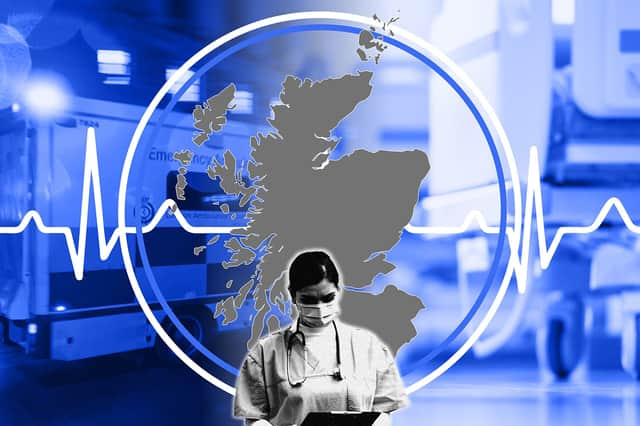NHS Scotland Covid tracker: 5 charts which show how much pressure Scottish hospitals are under this winter
This article contains affiliate links. We may earn a small commission on items purchased through this article, but that does not affect our editorial judgement.


Scotland, like the rest of the UK, saw record high coronavirus cases during the festive period.
While infections have begun to drop, the country’s healthcare system remains under acute pressure.
Advertisement
Hide AdAdvertisement
Hide AdThousands of NHS workers are off sick, hospital and intensive care Covid cases have increased, and bed blocking and A&E waiting times continue to cause problems for staff and patients alike.
How is your local health board or hospital coping this winter?
NationalWorld has analysed recent figures from Public Health Scotland and the Scottish Government to see how much pressure the NHS is under this January.
How many NHS workers are off with coronavirus?
Strict isolation rules combined with record high coronavirus cases has meant thousands of NHS workers are absent from work in Scotland.
Advertisement
Hide AdAdvertisement
Hide AdDespite England changing the rules so people testing positive will only need to isolate for five days, north of the border NHS workers still need to self-isolate for seven days.
The latest figures from the Scottish Government show an average of 7,174 NHS workers were absent from work due to coronavirus in the week to 11 January.
This is a 30.9% increase on the week before, when 5,482 were absent.
The latest figures are the highest weekly average since 28 April 2020 when 7,235 were absent.
Advertisement
Hide AdAdvertisement
Hide AdStaff included in the figures are nursing, midwifery, medical and dental staff.
Loading....
How many people are in hospital?
The number of people in hospital with coronavirus has been gradually increasing since the start of December.
On 3 January, 1,033 people were in hospital with the disease – the first time that figure has topped 1,000 d since 4 October.
The number of people in hospital has stayed above 1,000 since then, with 1,537 patients as of 12 January - a rise of more than 25% on the week before
Advertisement
Hide AdAdvertisement
Hide AdThis is the number of patients who tested positive in hospital or in the 14 days before their admission.
NHS Dumfries & Galloway has seen the greatest increase in hospital patients with 41 people in hospital at the latest count. This is 21 more than a week ago, a 105% surge.
Loading....
How many people are in intensive care?
The number of patients in intensive care units (ICU) with recently confirmed coronavirus has also been gradually increasing since the start of the year.
In the last two weeks hospitals across the country have seen a 75% increase in the number of patients needing this specialist care.
Advertisement
Hide AdAdvertisement
Hide AdAs of 12 January there were 59 people in ICU, 25 more than on 30 December when 34 were receiving treatment.
Hospitals in NHS Greater Glasgow & Clyde are currently treating the greatest number of ICU patients.
As of 12 January the health board had 15 people in ICU, followed by NHS Lothian with 10 and NHS Grampian with seven.
Loading....
How are delayed discharges affecting health boards?
Bed blocking continues to be an issue for health boards across the country.
Advertisement
Hide AdAdvertisement
Hide AdThe most recent Public Health Scotland data reveals 46,894 delayed bed days were recorded in November, averaging at 1,563 a day.
The number of bed days refers to the total number of bed days occupied by delayed discharges. A delayed discharge happens when a patient is clinically ready to leave the hospital but can’t for various reasons such as having no support or no suitable accommodation.
The number of days lost to bed blocking last year peaked in October at 50,185 delayed bed days were recorded.
That figure dropped 7% in November when 46,894 delayed bed days were recorded, averaging at 1,563 a day.
Advertisement
Hide AdAdvertisement
Hide AdAs of November, health boards had recorded nearly half a million (438,597) delayed bed days in 2021.
Loading....
How long are people waiting at A&E?
Accident and Emergency departments (A&E) continue to deal with thousands of patients.
Nearly 22,000 people visited A&E in the week to 2 January 2022. More than a third (36%, or 7,793 people) waited four hours or longer to be seen. Of these, 6,198 waited over four hours, 1,296 waited over eight hours and 299 people waited over 12 hours.
The current target is for 95% of patients to wait no longer than four hours from arrival to admission, discharge or transfer for treatment.
Advertisement
Hide AdAdvertisement
Hide AdMore people waited longer than four hours at A&E at Aberdeen Royal Infirmary than any other hospital in the country in the week to 2 January. Nearly half (49%) of A&E attendances, 496 people, waited longer than four hours to be seen.
NHS waiting times are defined as the time between arrival and the time of discharge, admission or transfer.
Loading....
A message from the editor:
Thank you for reading. NationalWorld is a new national news brand, produced by a team of journalists, editors, video producers and designers who live and work across the UK. Find out more about who’s who in the team, and our editorial values. We want to start a community among our readers, so please follow us on Facebook, Twitter and Instagram, and keep the conversation going.
Comment Guidelines
National World encourages reader discussion on our stories. User feedback, insights and back-and-forth exchanges add a rich layer of context to reporting. Please review our Community Guidelines before commenting.
